New Paradigm of the Belt and Road
Presented
at Washington Seminar
by William Jones
December 2016
A [PDF version of this article]appears in the December 9, 2016 issue of Executive Intelligence Review and is re-published here with permission.
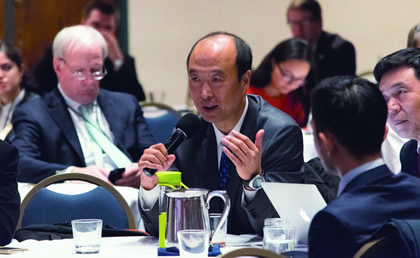
EIRNS/Jason Ross
Professor Liu Weidong in an exchange from the conference floor. |
Dec. 2—China’s Belt and Road Initiative has been garnering a great deal of interest in think-tanks around Washington in the aftermath of the U.S. elections, where some shift in U.S. foreign policy is expected as the new Trump Administration takes form. An event on Nov. 30 organized by the China Energy Fund Committee and the Institute for the Analysis of Global Security (IAGS) was something of a watershed in presenting the full breadth of the Belt and Road policy and tracking the reaction from the American side. While the forum gave an opportunity to both a high-level Chinese delegation and a group of U.S. think-tankers to present their views on the Belt and Road, in an attempt to find some level of agreement on U.S.-China cooperation with the Belt and Road, the forum also revealed stark differences in the philosophical outlooks from which the project is viewed from the two sides.
The wide-ranging initiative put forward by President Xi Jinping in September 2013 was initially called “One Belt, One Road.” The name is now deemed out-of-date, given that there are now six different routes of the Belt and Road, and it has been appropriately rechristened as simply the Belt and Road Initiative (BRI).
View full size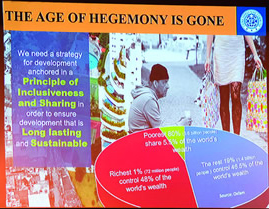 EIRNS/Jason Ross |
While the initiative is based on the construction of major transportation grids, including high-speed rail, conventional rail, highways, and seaports, these simply provide the basic platform for major investment and overall development in the regions criss-crossed by the transportation grid. It is a project that far outstrips the post-World War II Marshall Plan in scale, but its proponents shy away from comparisons with the Cold War Marshall Plan because it represents a new paradigm of thought. It rather harks back to the days of cooperation, trade, and cultural interpenetration which existed during the period of the ancient Silk Road.
The cultural paradigm shift represented by the BRI was most beautifully elaborated at the beginning and end of the forum by Patrick Ho, the secretary general of the China Energy Fund Committee, who had taken the initiative to organize the forum. “We live today in a threatened world,” he said. “There is great poverty, and although we have enough sources to go around for all of us, 2.8 billion people still lack resources. There is a lack of clean water for billions of people. Globalization created development as well as new problems. We are not sharing the fruits of progress.”
Inclusiveness a Stumbling Block
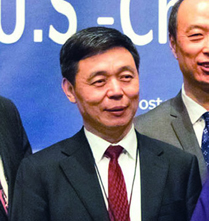
EIRNS/Jason Ross
Chen Guoqiang |
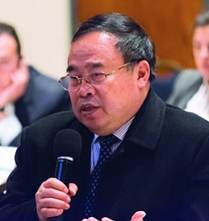
EIRNS/Jason Ross
Zhao Jinping |
“Globalization is now a system in crisis, a broken system. It cannot advance human progress. There are too many people left behind. We now need a holistic model that will be all-inclusive and a shift to a more sustainable and useful model,” Ho said. The Belt and Road is the form of that model. “Inclusiveness and sharing is the basis of the Belt and Road.” For China, he said, this was of great importance. Now having become the second largest economy in the world, China “had reached a new bottleneck in development and sought a “new model of growth and development.” “It found this in peaceful co-development and sharing with its neighbors, with a program which now encompasses 60 countries, affecting 4.9 billion people,” he said. As became clear during the course of the day, the issue of “inclusiveness” was something of a stumbling bloc for some of the U.S. interlocutors.
Chen Guoqiang, Director General in the Department of International Cooperation at the Development Research Center (DRC) of the State Council of China, lamented the lack of understanding in the West of the Belt and Road Initiative. He attributed this to the lack of information people are getting here and to consideration of what some people feel are their vested interests. He also expressed concern that too few Chinese scholars have come to the United States to explain the goals and the purpose of the initiative. Chen pointed out that under the present economic order, developing countries—totally dependent on developed countries—have not received the benefits of globalization.
Case for the Belt and Road
The purpose of the BRI is to create an economic order based on sharing, he said. The BRI is also consistent with China’s own domestic development program, China 2030. “Both programs respect the development priorities of each country and both stress the need for infrastructure,” Chen said. “The expansion of the BRI will provide benefits to China as well as to the world.”
“First,” Chen said, “it will provide sustainable public goods; second, it will further the extension of China’s development experience and its successful poverty reduction; and third, it will feature South-South cooperation as well as tripartite cooperation.
Zhao Jinping, also with the State Council’s DRC, underlined that the BRI would create a new space of cooperation and that it would also include the United States and Japan. It was also necessary, Zhao underlined, to enhance North-South and East-West cooperation. Liu Weidong called the Belt and Road a new stage of “inclusive globalization,” quoting a Chinese proverb, “In order to become rich, build a road.” Professor Li Xiangyang noted that the principle of “righteousness before profit was also relevant to the BRI. “President Xi said that we should have profit but also increase respect for China in the world. For the Belt and Road Initiative there is no set timetable and there are no quantitative measures,” Zhao said.
During the lunch session, Ziad Haider, the Special Representative for Commercial and Business Affairs at the U.S. Department of State, spoke of the U.S. view of the BRI. While the Obama Administration has largely ignored the BRI and discouraged other countries from joining the China-promoted Asian Infrastructure Investment Bank (AIIB), Haider indicated that there was some cooperation on the diplomatic level. He began his talk by focussing on the tremendous infrastructure needs of the world.
Haider called the BRI an “integrated vision” and indicated that there was an interest at the State Department in getting U.S. firms involved. He noted the Belt and Road’s importance in investment in infrastructure, in customs harmonization, and in the innovation connections in the Belt and Road countries. He said there were possibilities for more funding from the Overseas Private Investment Corp. (OPIC) and involvement of the Export-Import Bank to help U.S. firms participate. “China shouldn’t be the only player in this space,” Haider said. He also said that the State Department is working together with China’s National Development and Reform Commission, the agency primarily tasked with the development of the BRI. He also indicated that there was some progress toward cooperating with the AIIB.
Ingrained Geopolitics
View full size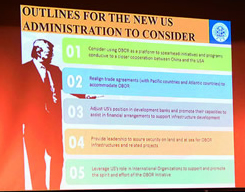 EIRNS/Jason Ross
|
While in the morning, there had been a session on the infrastructure needs of the world, focussing on the economic aspects of the Belt and Road, in the afternoon session, a number of scholars from Washington think-tanks dealt with some of the political aspects.
The aspects and concerns that they brought up clearly indicated the problems the U.S. side has in understanding the underlying philosophy of the Belt and Road. It was already manifest during part of the luncheon discussion, when Gal Luft from the IAGS reviewed a report he had done on the topic—made available at the event—entitled, “It Takes a Road: China’s Belt and Road Initiative: An American Response.” While the report had some very interesting details and maps of the Belt and Road routes, Luft’s comments were entirely imbued with geopolitical restrictions and considerations, reflecting the predominantly geopolitical outlook of the U.S. establishment that would quickly turn the BRI into a distant pipe-dream. Luft indicated great concern, for instance, over the railroad through Iran, since he didn’t think it would be proper to make Iran a “gate-keeper” of the Belt and Road.
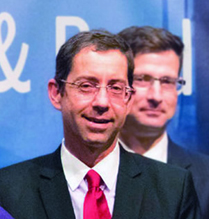
EIRNS/Jason Ross
Gail Luft |
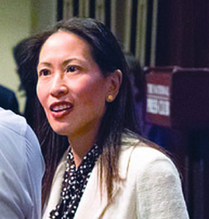
EIRNS/Jason Ross
Christina Lin |
This was also apparent in the afternoon panel with the U.S. think-tanks. While some of speakers, such as Christina Lin from the Center for Transatlantic Relations at Johns Hopkins, tried to get her fellow panelists to understand that we are now moving toward a “multipolar world,” most of the others were not at all keen on accepting that idea. Richard Hoagland, a former U.S. Ambassador to Kazakstan, who had expressed interest in the Belt and Road when President Xi announced the project, commented, rather cryptically, that in these big projects there are always “winners and losers.” But of course, in the geopolitical world, there is only a zero-sum game! Most telling were the comments of Daniel Markey, a senior research professor at the Johns Hopkins School of Advanced International Studies.
Geopolitics Confronted
View full size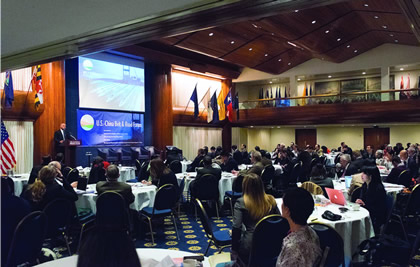
EIRNS/Jason Ross General view of the forum. |
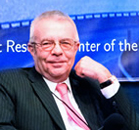
EIRNS/Jason Ross
Richard Hoagland |
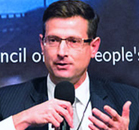
EIRNS/Jason Ross
Daniel Markey |

EIRNS/Jason Ross
William Jones |
Earlier in the day, EIR’s Bill Jones had raised the problem of the “geopolitical outlook prevailing in Gal Luft’s presentation,” noting that “the BRI could only succeed if we abandoned the geopolitical” mindset. Markey, perhaps referring to that little encounter, here rushed to the defense of geopolitics. Markey has made his professional mark in dealing with Pakistan, and was highly critical of China’s plan to build a road from Kashgar in western China to the port of Gwadar in Pakistan. Given the extreme poverty in the region and the unstable political situation, he thought that China’s only reason for building a road in this devastated region was geopolitical, namely for China to gain access to the Indian Ocean, making a rather snide comment that geopolitics cannot be replaced by “geo-economics.”
In the following Q&A, Jones directed a question to Markey, commenting sarcastically, “Oh, of course, such devastated areas like Syria or Iraq, or Gaza or even the Bronx, for that matter, would not be the most appropriate place to launch a Silk Road project. But the fact of the matter is that if you don’t launch a Silk Road there, they will always remain hell-holes for the people living there!” Even some of the panel nodded in agreement with Jones’ comment. While Markey fended this off somewhat cavalierly, he then got hit with a question from Alicia Cerretani with LaRouche PAC, who asked why Markey thought there was such a disconnect between the Chinese view and the American view he was expressing. Caught a bit off-guard by this, he wheedled his way out of that one too.
View full size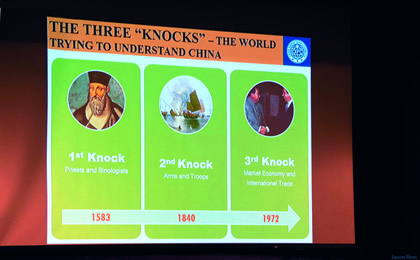
EIRNS/Jason Ross |
But this back-and-forth on the issue of geopolitics brought some of the Chinese speakers to their feet. Professor Liu Weidong expressed his frustration with the Americans who always try to “politicize” these issues that deal with the fate of millions of people. “That’s not the way we think about these things,” he said. Professor Zhao Jinping also expressed his objections. “With China’s rise, the United States always says it wants China to play a greater role. But China has fulfilled its responsibility as a major power by developing the Belt and Road. But some countries don’t see the BRI in a positive light. You have to understand that many countries have a terrible development gap. We don’t like everyone looking at this through a political lens. We certainly don’t, and this is a consensus we have come to in our study of the Belt and Road.”
The Stretto
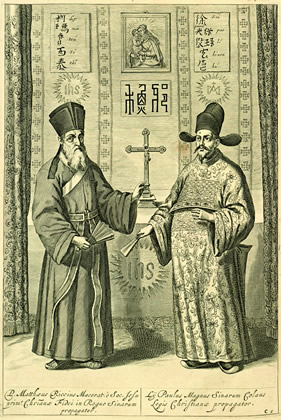
EIRNS/Jason RossT
Jesuit missionary Matteo Ricci (left) and a collaborator, the scholar Xu Guangqi (right), who took the name Paul, in a 1667 book illustration. |
Toward the conclusion of the forum, Patrick Ho had prepared his stretto to this somewhat dissonant symphony which he had helped to organize, presenting an expansive view of the development of China, leading to this present development in world history. “It is not possible for one section alone to have a sense of prosperity,” he said. “What we need today is a strategy for development, a long-lasting and sustainable one. We need wise consultation and joint contribution. Only through a win-win strategy can we gain a foothold. The Belt and Road is not a sphere of influence, but an accommodating of interests. It paves the way for the common destiny of mankind.”
Ho then went through the need to create a broad understanding of this project in order for it to succeed. Noting the rise of China in the period of its greatness, he also noted the “disconnect” in the understanding of China. “It may take hundreds of years for the West to understand China,” he said. “Marco Polo began the quest and then it was continued by the Jesuits Matteo Ricci and Joachim Bouvet [a correspondent of Leibniz]. This was the first dialogue between the two giant civilizations. And then the doors were callously closed.”
View full size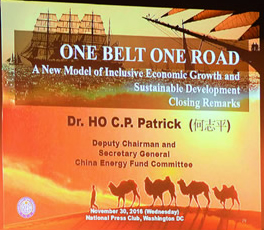
EIRNS/Jason Ross
Title of the forum. |
“After this, the Western countries expanded colonialism to the East,” Ho said, beginning what for China were a hundred years of humiliation. Now with the Belt and Road, China has re-emerged from those depths and become a major player. “The Belt and Road is a vision rather than a project, and a vision which is constantly expanding and may always do so. It is a connection of hearts and minds connecting souls, connecting the Chinese Dream with the American Dream and other dreams, freedom from want, freedom from fear, harmony with nature, and peace.”
He encouraged the United States to take part in this vision, proposing that the new Trump Administration consider the BRI as a platform for closer cooperation between the United States and China, realigning trade to accommodate the BRI, adjusting its posture in the international development banks to support infrastructure, and helping with security along the Belt and Road.
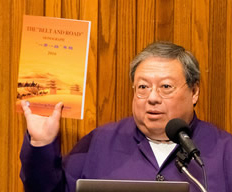
EIRNS/Jason Ross
Patrick Ho |
It is certainly to be hoped that the Trump Administration will agree to these proposals, but as we can see from the day’s forum, it will take an effort to change the mindset of our elected leaders who have such difficulty with that “vision thing.” We must begin by explaining to the American people, who have been so disappointed recently by the quality of political leadership in Washington, that there is a vision of a better world in which they also can be a part. They simply have to raise their eyes above the immediate horizon to see it, and to act accordingly to bring sanity to our nation’s institutions.
